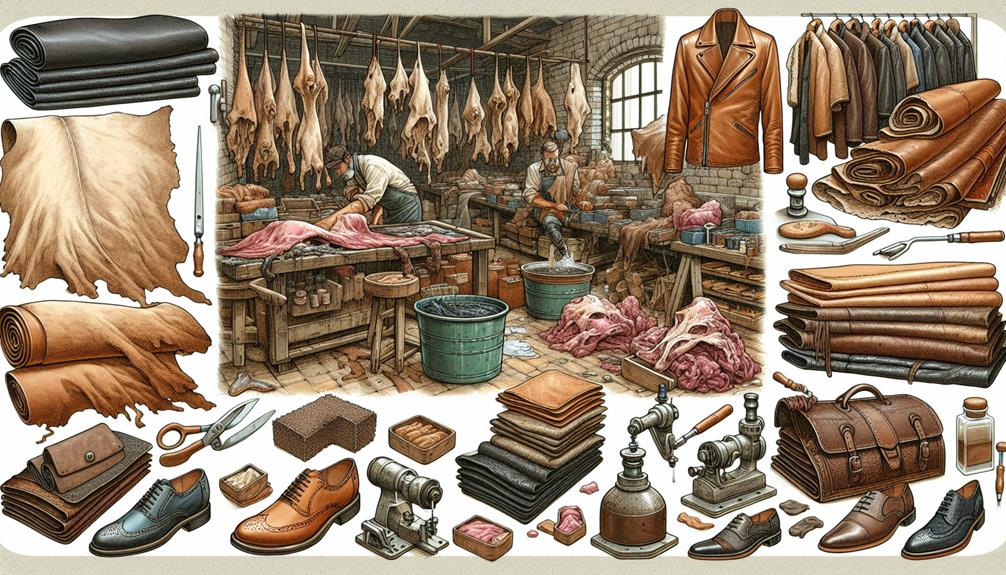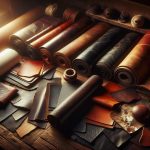I've found out a pretty cool fact about leather: it actually plays a big role in sustainability. You see, leather is primarily a by-product of the food industry. This means that making leather helps reduce waste by using the skins of animals that are already being processed for food. What's more, good quality leather can last ages, so you don't have to replace it as often as other materials. And if we're talking about types like full-grain leather, you're looking at some really durable stuff with a unique patina that only gets better with age. There's more to uncover about how sustainable and versatile leather can be.
Table of Contents
Key Takeaways
- Leather is a durable material that biodegrades within 10 to 50 years in landfills.
- Full-grain leather is the highest quality, showcasing natural grain and markings.
- Leather production utilizes by-products from the food industry, enhancing sustainability.
- Tanneries globally produce over 23 billion square feet of leather each year.
- Leather recycling supports a circular economy by repurposing waste into new products.
Origins of Leather
Leather first came around when people realized cow hides left in the sun could be used for warmth. It's fascinating how this discovery from the hide of cows evolved into the versatile material we use today. The origins of leather are rooted in necessity but grew through innovation and practical application. Early methods to extend its usability, like salting and smoking, were crucial. These processes helped preserve the leather longer, allowing our ancestors to benefit more from each hide.
As I delved deeper into how leather was processed historically, it became clear that removing flesh from the hide was a significant step toward improved comfort. This step in processing not only cleaned the hide but also enhanced its texture, making it more suitable for daily use. The inherent properties of leather, such as resistance to fire, fungi, and abrasion, also played a critical role in its popularity. These characteristics ensured that leather wasn't just a temporary fix but a durable solution for various needs.
Understanding these aspects gives me a deeper appreciation of leather's journey from a simple sun-dried hide to a highly sought-after material. Its natural properties and the early methods of preservation and processing laid the foundation for the leather industry as we know it today.
Leather Production Process
I've learned that the process of making leather starts with tanning and treating animal hides to turn them into durable and versatile materials. The leather production process is quite intricate and demands a high level of skill and technology, especially in tanneries that handle the bulk of this work globally. Annually, these facilities process over 23 billion square feet of leather, which really puts into perspective the scale of this industry.
What's fascinating is that leather is actually a by-product of the food industry. This means that the raw materials used in leather production are sourced from animals that are already part of the food consumption chain. By utilizing these hides, the industry helps in reducing waste and promoting sustainability.
Moreover, when the manufacturing process is environmentally controlled, it minimizes the impact on our surroundings. This involves proper training of staff, careful chemical handling, and efficient waste management. Each step is crucial to ensure that the leather production is responsible and as eco-friendly as possible. Learning about the careful balance of utility, sustainability, and environmental care within the leather industry has been incredibly eye-opening.
Types of Leather Grades
Let's talk about the different grades of leather and what makes each unique.
Starting with Full-Grain Leather, it's top-tier stuff because of its strong, natural features.
Then there's Bonded Leather, which is often used in various products because it's made from leftover hide pieces, making it super versatile.
Full-Grain Leather Attributes
Among the various grades of leather, full-grain leather stands out as the highest quality due to its durability and the unique patina it develops over time. It's the real deal for anyone who values quality and authenticity in their leather goods.
The beauty of full-grain leather lies in its ability to show off the natural grain, complete with the hide's original markings. These aren't flaws—they're proof of genuine, top-tier material. This leather is incredibly durable, resisting wear and tear like a champ.
Over time, it doesn't just endure; it evolves, gaining a rich patina that enhances its aesthetic appeal. Each piece becomes uniquely yours, telling a story of enduring quality.
Bonded Leather Uses
Bonded leather, made from leftover scraps and adhesives, often pops up in furniture upholstery and budget-friendly leather products. It's crafted through a manufacturing process that blends leather fibers with adhesives to form a cohesive material.
While it allows for cost-effective production, it's important to note that bonded leather is of lower quality compared to genuine leather. This difference in quality affects durability and appearance, making bonded leather less ideal for items requiring longevity or heavy use.
It's handy, though, for those who seek a leather look without the higher price tag of genuine leather. Just keep in mind, if you're opting for something like furniture upholstery, bonded leather mightn't hold up as well over time.
Leather's Environmental Impact
How does leather stack up when it comes to its environmental impact? Well, let's dive into the facts. One major plus is leather's durability and longevity. These qualities mean that leather products don't need to be replaced as often as their synthetic counterparts. This reduces the demand for resources and energy typically required for manufacturing new items. It's a win for sustainability!
Leather also biodegrades within 10 to 50 years in landfills, which is way faster than synthetic materials that can take hundreds of years to break down. And when it comes to oceans, leather's a good citizen too—it doesn't contribute to the microplastic pollution that's a huge environmental concern today.
What's more, leather items are repairable. They can be fixed up multiple times, which stretches their lifespan even further and cuts down on waste. It's like giving your favorite leather jacket or boots a new lease on life, instead of tossing them out.
And don't forget, the leather recycling sector is on the rise. New uses for recycled leather are popping up, helping to loop materials back into use rather than ending up as waste. All these points make leather a pretty solid choice environmentally speaking.
Leather and Sustainability
While diving into how sustainable leather really is, it's crucial to note that it utilizes animal by-products from the food industry, effectively reducing waste. This means fewer resources are thrown away, enhancing sustainability. When I look deeper into the process, it's clear that if leather manufacturing is environmentally controlled, its impact on the planet can be pretty minimal.
Leather's durability and longevity also contribute to a low carbon and water footprint. It's long-lasting, so you don't need to replace it as often as other materials. This reduces the demand for resources and the energy used in production cycles, which is a win for the environment.
Moreover, responsible leather production isn't just a buzzword; it's a necessity. It encompasses proper training and waste management, ensuring that the process doesn't harm the environment. This approach not only keeps our planet cleaner but also adds value locally in many countries, supporting communities and promoting sustainable practices.
Chemicals in Leather Making
In leather making, chemicals are used to tan and finish the product. It's a complex process, but stick with me here. Tanneries have to follow some pretty strict rules to make sure they're not harming the environment or us. For example, in Europe, tanneries comply with the EU REACH standards, which are all about controlling chemical use.
Now, the leather industry isn't stuck in the old days. We're seeing a shift towards modern biochemical solutions that minimize the need for harsh chemicals. This move isn't just good for our planet—it also means the leather you end up with is less likely to contain any nasty toxic materials. And honestly, who wants that?
Plus, there's a big push to get rid of chemicals derived from fossil fuels. Imagine leather production that's cleaner because it relies less on these pollutants. That's the goal.
Leather Biodegradability
Leather naturally breaks down over time, making it a more eco-friendly option than many synthetic materials. Unlike those stubborn plastics that linger in our environment, leather biodegrades, thanks to the handy work of bacteria and fungi. These microorganisms feast on the organic materials in leather, integrating it back into the ecosystem through the biodegradation process.
Here's why leather's ability to break down is so important:
- Speed of Biodegradation: Leather biodegrades within 10-50 years in landfills, which is significantly quicker compared to synthetic materials that can take hundreds of years.
- Natural Process: The biodegradation process involves natural organisms. Bacteria and fungi play crucial roles, breaking down leather without the need for harsh chemicals or processes.
- Reduces Pollution: As leather breaks down, it doesn't contribute to microplastic pollution. This is a major plus, considering the growing concerns about plastics in our oceans and soil.
Recycling Leather Possibilities
Let's talk about how we can give old leather new life. There are tons of clever ways to repurpose leather into items like wallets, belts, and even furniture.
This not only cuts down on waste but also has some great environmental perks. It's all about making the most of what we've already got and keeping it out of the landfill for as long as possible.
Leather Repurposing Methods
Recycling leather offers creative solutions like turning trimmings into carpets or wall coverings, significantly reducing industry waste. It's exciting to explore how the repurposing methods of leather can make a big difference.
The versatility of leather allows it to be transformed into various useful products. Here's a quick peek at some innovative ideas:
- Leather Fiberboard: Great for furniture and construction, showcasing the strength of recycled leather materials.
- Decorative Items: Leather scraps can be crafted into art or functional decor, adding unique touches to interiors.
- Fashion Accessories: Old leather gets a new life as bags, belts, or wallets, reducing the need to produce new materials and helping us all cut down on waste.
Environmental Benefits
I'm thrilled to explore how recycling leather greatly benefits our environment. The leather recycling sector is creatively reducing waste and enhancing sustainability. Recycled leather turns into products like chic wall coverings and durable carpets, proving it's not just eco-friendly but also versatile.
Here's a quick look at why leather recycling rocks:
| Benefit | Description |
|---|---|
| Reduces Waste | Leather remnants are reused, not trashed. |
| Eco-Friendly | Leather biodegrades faster than synthetics. |
| Promotes Sustainability | Supports a circular economy. |
| Innovative Uses | From fashion to interiors, possibilities abound. |
| Evolving Sector | Constant development in recycling practices. |
Alternative Leather Sources
Exploring alternative leather sources, like cork, pineapple leaves, and mushroom mycelium, offers a sustainable and cruelty-free choice. I've found that these options not only help reduce the environmental impact but also provide unique qualities that traditional leather can't offer. Let's dig a bit deeper into these fascinating materials.
Cork leather, for instance, comes from the bark of cork oak trees. It's not only lightweight and water-resistant but also incredibly durable, making it a practical choice for everyday use. Then there's pineapple leather, or Piñatex, which is crafted from the fibers of pineapple leaves. It's not just versatile; it's also biodegradable, which is a huge win for our planet. Finally, mushroom leather, known as Mycelium leather, is made from fungal mycelium and agricultural waste. This material is a standout for its sustainability and innovative approach.
Here's a quick rundown of what makes these materials special:
- Cork Leather: Lightweight, water-resistant, durable
- Pineapple Leather (Piñatex): Biodegradable, versatile
- Mushroom Leather (Mycelium): Sustainable, innovative
Using these alternative leather sources is a smart move for anyone keen on making environmentally conscious choices without sacrificing quality or style.
Global Leather Trade
Now let's take a look at the global leather trade.
We'll start by checking out who the major leather exporters are and which countries are the biggest buyers.
Then, we'll explore how trade regulations impact this international market.
Major Leather Exporters
When it comes to leading leather exporters, China tops the list, followed closely by Italy and Vietnam. It's fascinating to see how each country plays its part in the global leather scene. Italy, renowned for its high-quality craftsmanship, holds the spot as the second-largest leather goods exporter. Similarly, countries like Brazil and India aren't far behind, contributing significantly with their rich resources and skilled labor.
- China: Dominates the market with the highest export value.
- Italy: Known for premium quality and design.
- India & Brazil: Major players with substantial exports.
As someone deeply intrigued by the global trade dynamics, I find the diversity and scale of exports across these countries particularly interesting. The United States also chips in, being a notable contributor despite being eighth in line.
Import Markets Overview
Let's take a closer look at the key import markets that play a vital role in the global leather trade. Italy is renowned for its leather craftsmanship, significantly contributing to the leather business in Italy's economy. It ranks second only in exporting leather goods, showcasing their expertise in high-quality leather products.
Meanwhile, the United States ranks 8th in leather production, exporting about 25% of its leather goods. It's fascinating to see how leather footwear contributes to 60% of the industry's revenue, underlining its massive impact.
The global leather industry generates a whopping $53.8 billion USD annually, proving just how substantial this sector is. These markets are crucial in the intricate web of worldwide leather trade dynamics.
Trade Regulations Impact
Navigating the maze of global trade regulations is crucial for leather businesses aiming to thrive internationally. Understanding these rules helps companies tackle challenges in international trade, ensuring they can compete effectively in the global market. Compliance isn't just a legal necessity; it's a strategic advantage in the leather industry.
Here's a quick breakdown:
- Trade Agreements: Shape how leather goods move across borders, influencing market dynamics.
- Tariffs and Quotas: Directly impact the price and availability of leather products in foreign markets.
- Sanitary Regulations: Ensure that leather goods meet specific standards, crucial for maintaining market access.
Staying ahead means keeping up with these regulations and leveraging them to optimize your business strategy. It's all about playing the game smart!
Verifying Leather Authenticity
To ensure you're getting the real deal, always check for a stamp or label that verifies the type and origin of the leather. This simple step is crucial for confirming leather authenticity.
When you're shopping, keep in mind that not all leather products are created equal. For instance, genuine leather, despite its appealing name, is actually the lowest quality of real leather, typically made from the less desirable layers of the hide.
If you're after something more premium, aim for full grain leather. It's the most genuine and highest quality leather you can find, known for its durability and ability to develop a rich patina over time.
Then there's top grain leather, which is a step below full grain. It's been sanded to get rid of imperfections, giving it a more uniform look but sacrificing some of the natural strength.
Understanding these differences not only helps you make better purchasing decisions but also ensures you're not fooled by appearances. So, next time you're evaluating leather items, give them a thorough check. Your savvy shopping skills will pay off, guaranteeing you invest in pieces that are both beautiful and lasting.
Leather's Role in Deforestation
Despite its significance, the leather industry's role in deforestation is complex and multifaceted. It's easy to point fingers solely at the industry for cutting down trees, but there's a lot more to the story. The leather industry actually champions sustainable practices, aiming to minimize its environmental footprint. It's not just about making leather; it's about doing it responsibly.
Here's a closer look at how things really stand:
- Cattle and Ownership: In some regions, cattle are used strategically to establish land ownership. This sometimes leads to deforestation, but it's more about land claims than leather production per se.
- Fighting Deforestation: The industry is actively opposing deforestation. For instance, research in Brazil shows that grasslands, which support cattle, can actually help improve carbon emissions figures without needing to destroy forests.
- Efficient Practices: The rising demand for meat and dairy is increasingly met through improved husbandry practices. This efficiency reduces the pressure to clear more land, aligning with the leather industry's commitment to sustainability.
Frequently Asked Questions
What Is an Interesting Fact About Leather?
You're asking about leather? Here's a cool fact: it's not just cows; exotic leathers can come from ostriches, kangaroos, and even eels, offering unique textures and luxury that ordinary leathers just can't match.
What Is Special About Leather?
Leather's special because it's naturally durable, resistant to tears, and breathable. It's versatile, ideal for everything from fashion to furniture, and each type offers unique textures and properties for various uses.
What You Need to Know About Leather?
I've learned that leather's durability and low environmental impact make it a sustainable choice. Properly managed, it's produced with minimal waste, and its longevity means less frequent replacement, reducing its overall footprint.
What Is a Fact About Leather Bag?
I've learned that leather bags are not only stylish but incredibly durable, often improving with age, and can be a sustainable fashion choice if maintained properly. They truly stand the test of time.
- How Does Ring Spun Cotton Affect Garment Fit and Shape Retention? - August 13, 2024
- What Are the Challenges in Producing Ring Spun Cotton? - August 13, 2024
- Is Ring Spun Cotton Suitable for Plus-Size Clothing? - August 13, 2024







